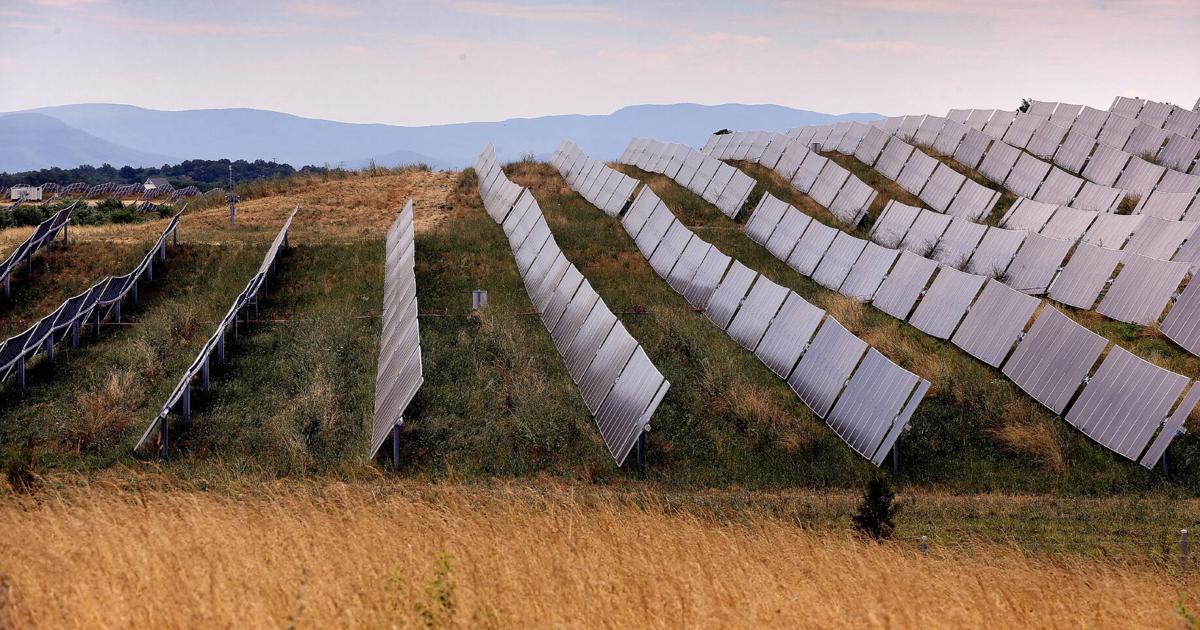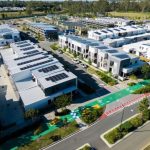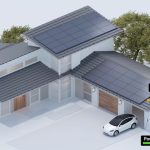The network of ground-mounted solar panels continues for countless rows amid the rolling hills of southern Frederick County, the Blue Ridge Mountains looming in the distance, not far from Stephens City.
This is the Bartonsville Solar project — a massive solar power-generating facility built on nearly a thousand acres once home to orchards and farmland. A gravel construction entrance, flanked by an orchard, is located off Marlboro Road. The roughly 315,000 solar panels are visible from Springdale Road near Middle Road.
“Bartonsville Solar Site,” reads a sign.
Construction is almost complete, according to Torch Clean Energy developing manager Sam Gulland. In terms of investment, he said the total cost of the project exceeds $150 million. It is a 130-megawatt (alternating current) facility. “That’s kind of like the max power,” Gulland explained. “At any instant, at noon on a sunny day, it would be putting 130 megawatts onto the [electric] grid.”
The renewable energy infrastructure project could come online later this year, upon connection to a nearby First Energy 138-kilovolt transmission line. The site — which is being developed by Torch Clean Energy and is owned by D.E. Shaw Renewables — includes 4,100 rows of trackers, which are devices used to alter the position of the solar panels to face the sun.
The Bartonsville project is the largest of four “solar farms” approved by the Frederick County Board of Supervisors from 2020 to December of 2022. That period represented something of a boom in interest in solar power development in the locality.
The project will contribute “significantly to reducing reliance on fossil fuels, decreasing greenhouse gas emissions, and mitigating climate change impacts,” says a post on the website of MYR Energy Services, the construction company building the facility.
The large installation of panels will generate electricity from light and heat emitted by the sun and route that electricity to a regional power grid for distribution.
Meanwhile, construction is continuing on a separate solar farm nearby. A 669-acre solar generation facility with 416 acres of panels — developed by Foxglove Solar LLC of Stevensville, Maryland — is “basically adjoining” the Bartonsville project in terms of proximity, Frederick County Planner Tyler Klein said, with construction “moving full steam ahead.”
Here’s the status of the four solar power projects that received conditional-use permits (CUP) from the Board of Supervisors:
Richmond-based Urban Grid, representing Foxglove Solar LLC of Stevensville, Maryland, is developing a solar facility on approximately 669 acres in the vicinity of Hites, Marlboro, Klines Mill, Clark and Vaucluse roads in the Back Creek District. It was approved in 2020.
The Bartonsville site, which is nearing completion, is located along Passage Road (Route 648), Marlboro Road (Route 631), Springdale Road (Route 649), Middle Road (Route 628), west of the CSX rail corridor and partially within the Stephens City town limits. It was approved in 2020.
A CUP for an 83-acre, 20-megawatt facility solar power facility in Gore was approved in 2022. The property is located south of Parishville Road (Route 610), south of the cul-du-sac of Anchorage Lane (Route 1416), and north and west of Hollow Road (Route 707). A site plan has not been approved for this project. Construction has not begun.
In 2022, a 263-acre facility on nine parcels totaling 447 acres in eastern Frederick County received CUP approval. The properties are generally located east of Woods Mill Road (Route 660) and north of Pine Road (Route 661), approximately 0.5-miles north of Berryville Pike (Va. 7). A site plan has been approved but construction has not begun.
The development of renewable energy infrastructure has been a hot topic in Virginia, particularly since 2021, when the Democratic-majority General Assembly passed the Virginia Clean Economy Act. This requires the state’s electric grid to decarbonize by 2045 by transitioning to renewable energy sources and retiring fossil fuel generation sources.
According to a 2023 report from regional grid operator PJM, “Virginia’s peak load growth is projected to range between -0.5 and 5.2% annually over the next 10 years, depending on the service territory,” driven in part by the proliferation of data centers in Northern Virginia.
The Washington Post reported recently that energy availability remains a concern, based on expected future demand. While clean energy projects have been approved or are being constructed in Virginia — such as Dominion’s 2,600-megawatt wind farm in Virginia Beach — some of those projects won’t be ready in time to absorb projected gaps in energy availability.
“This is an area of growing demand for electricity,” Gulland said.
“It’s the broad PJM stuff and then, and it’s the manufacturers and the data centers, that’s all going up … but even locally, there’s a growing demand for power,” he added.
In rural parts of the U.S., solar farms have stirred controversy as rural landowners lament the loss of agricultural land and impacts on the viewshed. Advocates often tout the role of renewable energy solutions in slowing climate change, stressing the urgent need to get solar and wind farms online.
Earlier this year in neighboring Clarke County, that jurisdiction’s Board of Supervisors adopted a zoning ordinance amendment essentially prohibiting any solar farms from being established in the future in the county of roughly 15,000 people. That followed the supervisors requesting that county planners come up with rule changes to discourage solar farm development, fearing it would take away land needed for agricultural farms.
“We’re fighting for the soul of the county,” Clarke County resident John Engels said at a public hearing on the matter, adding that solar farms “ruin land for agricultural uses” and detract from the agrarian character the county has fought to maintain.
Lunenburg County also has a solar ban, while the counties of Henry, Mecklenburg, Pittsylvania, Isle of Wight and Nottoway impose limits on the amount of land that can be used for solar, The Virginia Mercury reported this year.
According to The Virginia Mercury, members of the energy industry maintain those restrictions are having a dampening effect on solar development in the state.
Frederick County has taken no such action.
“Projects like Bartonsville provide significant tax revenue to the County, and the cost to the County is zero. This is a win-win, especially in counties that are seeing more and more farmland carved up into 5-acre residential lots that require more roads, schools, utilities,” wrote Gulland in an email, adding that the project will pay over $10 million in personal property and real estate taxes during its lifespan.
The Bartonsville project won the 2024 Governors Environmental Excellence Award, thanks to “innovative new technology and a proactive approach to protecting the integrity of the natural landscape, stormwater runoff, and vegetation,” according to MYR Energy Services.
The project encompasses six separate homerun circuits, featuring a total of 41 power blocks and associated power conversion stations.
“Facing the challenging topography at the foot of the Appalachian Mountains, characterized by hilly terrain, below-grade rock, and karst features, the Bartonsville Solar project was designed using the Nevados all-terrain trackers. This tracker system, utilizing a modular bearing system, adapts to the natural curves of the landscape with minimal required grading, aligning with environmental conservation principles,” says a post on the MYR website.
This means the tracker system is designed to minimize grading, allowing for up to 15 degrees of slope in either direction so that there is little topsoil or soil disturbance.
Frederick County experienced significant suburban expansion in the 1970s, 1980s and 1990s. From 2020 to 2022 alone, the county’s population increased 3.6%, from 91,731 to 94,871.
Driving on Marlboro and Middle roads, it’s evident that new residential development has occurred recently in this part of the county, in the vicinity of the Bartonsville solar farm.
At the January 2020 meeting where the supervisors approved a conditional-use permit for part of the Bartonsville facility, former Gainesboro Supervisor J. Douglas McCarthy noted that the project had drawn the support of some residents of southern Frederick County while indicating that, generally, similar proposals for solar facilities had drawn some opposition in the past.
“This is an interesting one because it’s, I think, the first one where we haven’t had a lot of vociferous opposition,” he said at the time. “This is one where I’ve actually had people saying, ‘I want this in my backyard,’ which, that’s a first.”
This post was originally published on 3rd party site mentioned in the title of this site




